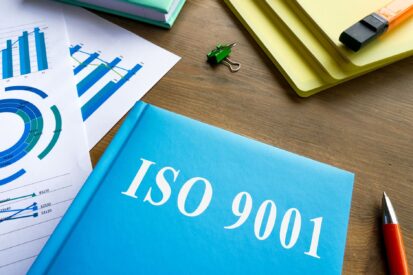Preparing for an ISO 9001 audit can be a daunting task for many businesses. It requires meticulous planning and a clear understanding of the audit process. ISO 9001 sets out the criteria for a quality management system and is based on a number of quality management principles, including a strong customer focus, the motivation and implication of top management, the process approach, and continual improvement.
Achieving ISO 9001 certification demonstrates our commitment to quality and continuous improvement. It shows that we are dedicated to meeting customer requirements and enhancing customer satisfaction. The audit process ensures that our quality management system is effective and complies with the ISO 9001 standard.
Proper preparation for an ISO 9001 audit involves several key steps. From understanding the audit process to making sure all necessary documentation is in place, each step is crucial. Overcoming common challenges and knowing the post-audit actions can help us maintain compliance and continually improve our processes. This guide will take us through everything we need to know to prepare effectively for a successful ISO 9001 audit.
Understanding the ISO 9001 Audit Process
The ISO 9001 audit process is designed to evaluate our quality management system against the ISO 9001 standard. This helps us ensure that we are meeting the required criteria and continuously improving our processes. The audit process typically involves two stages: the internal audit and the external audit.
The internal audit is conducted by our own team or an internal auditor to evaluate our preparedness for the external audit. This step helps identify any gaps or areas for improvement within our quality management system. It also ensures that our documentation is up-to-date and compliant with ISO 9001 standards.
The external audit, also known as the certification audit, is carried out by a third-party auditor from an accredited certification body. This auditor reviews our entire quality management system to verify its compliance with ISO 9001 requirements. The external audit usually has two main parts: the Stage 1 audit and the Stage 2 audit. During the Stage 1 audit, the auditor reviews our documentation and readiness for the full audit. The Stage 2 audit involves a more in-depth evaluation of our processes and controls.
Understanding these stages helps us better prepare for the audit, ensuring that our quality management system is robust and compliant.
Key Steps to Prepare for the Audit
Proper preparation is essential for a successful ISO 9001 audit. Here are the key steps to take:
- Review Documentation: Ensure all documentation related to the quality management system is accurate and up-to-date. This includes our quality manual, procedures, work instructions, and records. Proper documentation demonstrates our commitment to quality and conformity with ISO 9001 standards.
- Conduct Internal Audits: Perform regular internal audits to identify any non-conformities or areas for improvement. Internal audits help us address issues before the external audit, ensuring we are fully prepared.
- Management Review Meetings: Hold management review meetings to discuss the performance of our quality management system. These meetings provide an opportunity for top management to review audit findings, set quality objectives, and make necessary improvements.
- Employee Training: Train our employees on ISO 9001 requirements and the importance of their roles in maintaining the quality management system. Well-informed employees can help us maintain compliance and improve our processes.
- Corrective Actions: Identify any non-conformities from internal audits or previous external audits and take corrective actions. Implementing effective corrective actions helps us address root causes and prevent recurrence.
- Create an Audit Plan: Develop a detailed audit plan outlining the scope, objectives, and schedule of the audit. This plan ensures that everyone is aware of their responsibilities and what to expect during the audit.
By following these steps, we can effectively prepare for the ISO 9001 audit, ensuring our quality management system is compliant and ready for evaluation.
Common Challenges and How to Overcome Them
Preparing for an ISO 9001 audit can present several challenges. Identifying these obstacles early and knowing how to address them ensures a smoother audit process.
- Incomplete Documentation: One common challenge is having incomplete or outdated documentation. This can hinder the audit process. To overcome this, regularly review and update our documentation. Schedule periodic checks to ensure everything is current and accurately reflects our procedures.
- Lack of Employee Awareness: Employees may not fully understand ISO 9001 requirements or their roles in the audit process. Conducting regular training sessions and awareness programmes helps ensure that everyone knows what is expected of them. Encourage open communication so employees feel comfortable asking questions.
- Inconsistent Processes: Another challenge is maintaining consistency in our processes. Variations can lead to non-conformities. Implementing standard operating procedures and routinely monitoring compliance can help address this issue. Regular internal audits also identify inconsistencies early, allowing us to take corrective action.
- Resource Constraints: Sometimes, we may face limitations in terms of time, personnel, or budget. To mitigate this, plan the audit preparation well in advance. Allocate resources strategically and consider seeking external support if necessary.
By recognising these challenges and proactively addressing them, we can ensure a more efficient and successful ISO 9001 audit.
Post-Audit Actions and Continuous Improvement
Once the audit is complete, our work doesn’t end there. To maintain ISO 9001 certification and enhance our quality management system, several post-audit actions are necessary.
- Review Audit Findings: Carefully review the auditor’s report and findings. Identify any non-conformities or areas for improvement. Understanding these findings helps us address issues effectively.
- Implement Corrective Actions: Develop a corrective action plan to address any non-conformities highlighted in the audit. Assign responsibilities and set deadlines to ensure these actions are completed promptly and effectively.
- Continuous Monitoring: Regularly monitor our processes and quality management system to ensure compliance and effectiveness. Implementing a routine schedule for internal audits and reviews helps us stay on track.
- Engage With Stakeholders: Communicate the audit results and subsequent actions with relevant stakeholders. This includes employees, management, and external partners. Transparency fosters trust and encourages continuous improvement.
- Plan for Future Audits: Start preparing for the next audit cycle early. Use the insights gained from the current audit to enhance our preparation for future audits. Continuously seek ways to improve our processes and systems.
By taking these post-audit actions, we can ensure ongoing compliance with ISO 9001 standards and drive continuous improvement in our organisation.
Conclusion
Preparing for an ISO 9001 audit requires careful planning, thorough documentation, and active involvement from all team members. By understanding the audit process, taking key preparatory steps, overcoming common challenges, and engaging in continuous improvement, we can achieve and maintain ISO 9001 certification.
The journey to ISO 9001 compliance is a continuous one, where each audit provides valuable insights into how we can improve our quality management system. Staying committed to quality and being proactive in our approach will help us meet customer expectations and drive our business forward.
For expert guidance and support in preparing for your ISO 9001 audit requirements, reach out to ISO 9001 Consultants. Our experienced team can help you navigate the audit process with confidence and ensure your success.








Users Comments
Get a
Quote